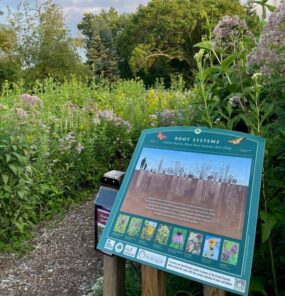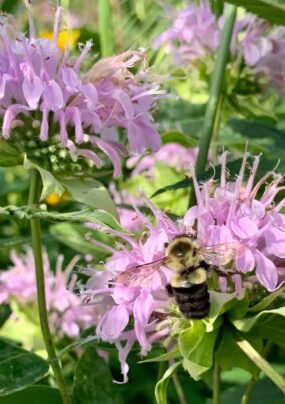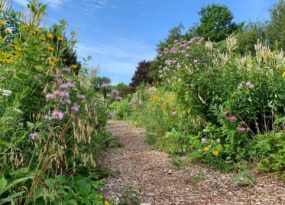Prairie Garden
INTERESTED IN DETAILED PRAIRIE PLANT INFORMATION? Please visit our Prairie Plants Page for more: scientific name, general location in our Prairie Garden, approximate bloom time, color, height, and interesting notes.
Our free-spirited, old-fashioned rose garden and prairie plantings were established by the late Marlyn Bausman in memory of his daughter, Jodi. Many of our vintage roses, known for their fragrances, are more than 100 years old. Prairies have been the defining native landscape of Iowa, and this plot features prairie plants once found across the state. Beginning roughly 8,000 years ago, the deep and complex root systems of prairie plants created the rich soil of Iowa's farmlands. The first settlers were greeted by this sea of tall grasses and a rainbow of flowers, with names like Big Bluestem, Compass Plant, Shooting Star, and Butterfly Milkweed. The early pioneer hunters would burn the prairies so that the buffalo were easier to hunt. Because of the grasses’ deep roots, they would likely survive and grow back in time.

Marlyn Bausman
Dickinson Poem #1755
To make a prairie it takes a clover and one bee,
One clover, and a bee.
And revery.
The revery alone will do,
If bees are few.
Perhaps you read and analyzed this Emily Dickinson poem in an English class years ago. Some suggest the poet was speaking of creating a “good life” with what is at hand, however meager.
What is important is our dreams, vision and intent; our perseverance to create beauty where there is none, to bring light out of darkness.

Published in GROUND COVER's Spring 2023 Issue
Rediscovering
the Bausman Memorial Prairie
Forty years ago Marlyn Bausman and the other founders of the Dubuque Arboretum and Botanical Gardens had a vision to create our gardens, and Marlyn literally made a prairie. Of course his revery did not recreate the vast landscape of waving grass and the tapestry of blooms, insects and birds that wove among them over the growing season. That is a dream that will only exist in our minds. As Aldo Leopold, the visionary Wisconsin ecologist, wrote in A Sand County Almanac:
Yet, you can wander into the Jodi Bausman Memorial Prairie Garden in summer, allow the heat and buzz of insects to envelop you, and invite the daydream of the once-immense Midwestern prairie to slowly creep into you. Here you may see flowers that are new to you, insects of varied shapes and colors, a butterfly casually floating to just the right nectar source, or a goldfinch, Iowa’s state bird, feeding on a seed stalk.
Sorry, no buffalo here; but there are a few compass plants, sending up towering flower spikes. Their leathery, oak-leaf-shaped foliage is oriented more or less northsouth, perhaps collecting all the sunlight possible while minimizing water loss. It may well take a decade for a compass plant to achieve flowering when planted from seed. Making a prairie is not an endeavor for an impatient gardener, however inspired.
Over the course of 2022, while volunteering in the Prairie Garden, I counted 57 species of native flowering plants and grasses, a few, according to Marlyn’s notes, right where he planted them in 1983. A silently gliding wild turkey brushed my arm, I nearly stepped on a motionless fawn, and a garter snake startled me awake from my own pleasant distractions.
I encourage you to visit the Prairie Garden often as this is a subtly changing but dynamic garden. The curtain rises on a brown and drab stage, but you might see the delicate shooting star in May, followed by white false indigo, blue spiderwort and delicate penstemons in June; a riotous continuum of taller yellow and purple blossoms in July and August; and the final act of early fall asters and a solitary blue gentian visited by the last bees of the year. Then, the plant stalks go silent and slowly recline with the winter’s snow and ice and release their minerals in the spring’s burn, restarting the cycle. The play reruns, an understated drama on this small prairie stage where a long-ago revery is now quite alive— a testament to a vision and remembrance.
By John Brennan, Prairie Volunteer Leader
WITH APPRECIATION to the Prairie Volunteer Team for the care and maintenance of the Prairie Garden.










